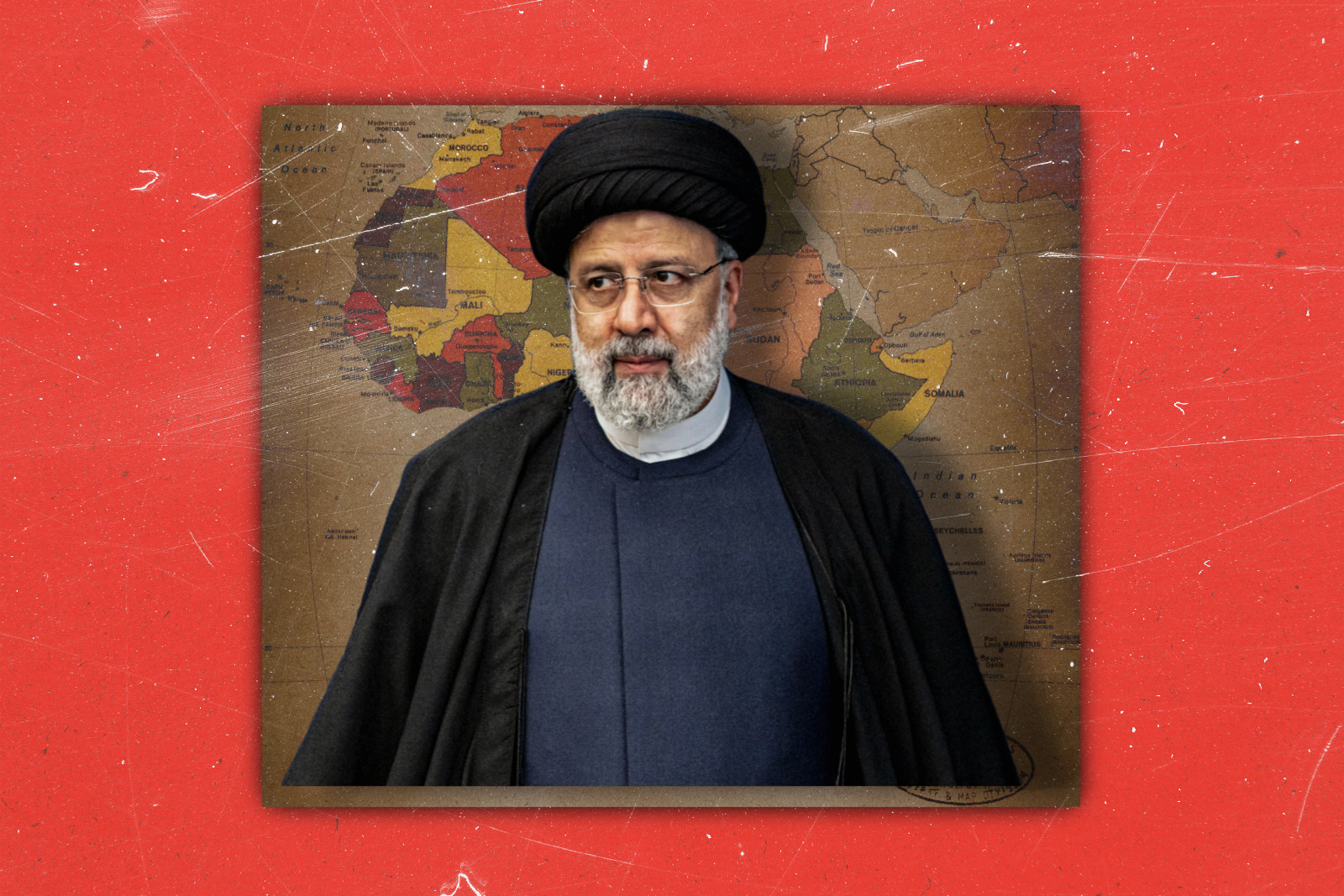
Iran’s Complicated Dance with West Africa
As Iranian President Ebrahim Raisi concluded his second year in office this June, his focus shifted southward and eastward. Earlier in the year, he embarked on a diplomatic tour of three Latin American countries under U.S. sanctions—Venezuela, Nicaragua, and Cuba. Then, in July, he pivoted to Africa, visiting Kenya, Uganda, and Zimbabwe, nations that have either been top trading partners or enduring allies of Iran.
Entering his third year at the helm, Raisi has now set his gaze on West Africa. On August 24, following a March meeting between the Iranian and Senegalese foreign ministers in Geneva, Raisi met with Senegal’s President Macky Sall on the sidelines of the BRICS summit in South Africa. Notably, Iran, along with its regional rivals Saudi Arabia and the United Arab Emirates (UAE), attended as new members.
Just over a week later, on September 4, Raisi welcomed Burkina Faso’s Foreign Minister Olivia Rouamba to Tehran. Echoing his meeting with Sall, discussions centered on anti-colonial sentiment, sanctions resistance, technology transfer, and economic cooperation, punctuated by the formalization of a Joint Commission for Economic Cooperation between the two nations.
These interactions reflect Raisi’s ongoing strategy to cultivate relations with West Africa. Within days of taking office on August 6, 2021, he engaged in talks aimed at fortifying parliamentary cooperation with the National Assembly speakers of South Africa—his country’s largest trading partner in sub-Saharan Africa—and Guinea-Bissau. Several months later, in January 2022, Raisi hosted Togo’s foreign minister, Robert Dussey, in Tehran, where they discussed similar themes.
For Raisi, these diplomatic forays aim to lend credibility to the Islamic Republic by showcasing its alliances in West Africa and the Global South—especially in the face of relentless pressure from the United States. They also represent an attempt to reset Africa-centric diplomacy that had waned under his predecessor, Hassan Rouhani, during the Iran nuclear deal negotiations with the Obama administration. Under Raisi, Iran finds itself presented with myriad opportunities but also formidable constraints in bolstering its relationships with West Africa in the realms of economics, geopolitics, and culture.
Economically, among the four Western African countries Raisi has publicly engaged, Senegal offers the most commercial promise. During President Mahmoud Ahmadinejad’s tenure from 2008 to 2013, Iran established tractor and automobile plants in Senegal and exported vehicles to neighboring countries like Gambia, Ghana, Mali, and Nigeria. These facilities, after a hiatus, resumed operations under Raisi in late 2021.
Also of note is the export of gold from West African nations such as Togo, Senegal, and particularly Burkina Faso. Although currently low, their gold could offer Iran a hedge against inflation and price volatility aggravated by governmental mismanagement and internal dissent.
Geopolitically, Togo could potentially serve as a uranium source for Iran’s nuclear program, echoing relations Iran once pursued with other West African nations like Malawi, Niger, and Sierra Leone under Ahmadinejad. At the United Nations and within other institutions, these nations have given Iran diplomatic cover on issues ranging from its nuclear program to human rights.
To cement this diplomatic backing, Iran has pursued bilateral agreements in diverse areas such as security, healthcare, agriculture, energy, technology, and transportation. Iran has further fortified commercial, consular, and legislative ties through high-level meetings dating back to 2018.
Culturally, Raisi and West African leaders have underscored shared historical experiences of colonialism, resource exploitation, and sanctions. Iran has even managed to convert Sunni, Sufi, and non-sectarian Muslims in countries like Nigeria and Senegal to Shiism through institutional and local outreach.
Iran finds itself ensnared by limitations as it seeks to deepen its bonds with West Africa. Though it inked a preferential trade agreement with Senegal back in 2008, the economic relationship between Iran and West Africa remains anemic. Historically, Iran has looked toward southern and eastern Africa for trading partners; from 1979 to 2018, its top allies have been situated there. Within the tapestry of Iran’s 46 trading partners in sub-Saharan Africa, Nigeria and Ivory Coast emerge as outliers, ranking ninth and tenth, respectively. During the same timeframe, nations like Togo, Senegal, Burkina Faso, and several others lag far behind, registering merely a sliver of Iran’s total trade volume with the continent.
In 2021, these West African nations found more robust trade partners in Saudi Arabia and the UAE—Togo’s chief export destination. Beyond the Middle Eastern sphere, Iran’s economic rapport with these countries is eclipsed by its ties to more substantial and historically established economies like China, France, India, the Netherlands, and Switzerland.
Moreover, the financial calculus complicates things further. West Africa’s low- and lower-middle-income nations grapple with acute investment and capital shortages. As of 2022, their GDPs varied from Guinea-Bissau’s paltry $1.6 billion to Senegal’s more robust $28 billion. These economies eye Iran’s $389 billion GDP as a potential lifeline. Yet, for all its economic advantage over West Africa, Iran’s sanctions-laden status and other obstacles have stymied any sizeable investments.
During Ahmadinejad’s presidency and as recently evidenced by President Raisi’s meeting with Senegal’s Sall in August, Iran has sought to foster private sector partnerships in countries like Guinea-Bissau and Senegal. Iranian entrepreneurs, keen to stay in the regime’s good graces, participate in these meetings. However, aside from these formal interactions, they exhibit hesitancy to significantly invest in West Africa. This reluctance is fueled, in part, by the region’s sociopolitical instability—a reality underscored by the array of coups and coup attempts between 2020 and 2023 in countries such as Burkina Faso, Gambia, Guinea, Guinea-Bissau, Mali, Niger, and Sierra Leone.
Geopolitically, Iran’s relations with some West African countries are fraught, exemplified by its past with Senegal. Senegal and Gambia cut off diplomatic relations with Iran between 2010 and 2011, accusing Iran of arming rebels in Casamance. The rupture extended into the UN General Assembly, where both nations altered their stances and voted for resolutions condemning Iran’s human rights abuses. However, each diplomatic setback was followed by a rapprochement, generally focused on economic ventures like agriculture.
Culturally, Iran has made inroads in converting some Muslims to Shiism but faces demographic roadblocks and rivals from abroad. Senegal, a majority Sunni and Sufi nation, once shuttered the Iranian embassy in 1984 for promoting Shiism. Although relations were rekindled in the early 1990s, Iranian entities like Al-Mustafa University find themselves in fierce competition with Sunni and Salafist institutions, many of which are backed by Saudi Arabia and other Gulf states.
While Iran may glimpse opportunities for economic, geopolitical, and cultural engagement with West Africa, it must navigate an intricate maze of resource limitations, international rivals, and demographic challenges. Amid the recent diplomatic overtures brokered by China between Iran and Saudi Arabia, and Iran’s ascension to groups like BRICS and the Shanghai Cooperation Organization, West African countries like Senegal now have increased diplomatic latitude to engage with Iran. Yet these engagements remain colored by constraints. Assuming the United States and its Western allies permit it, Iran might find itself recalibrating its foreign policy towards a stance more in line with its founding doctrine of neutrality—of belonging neither to the East nor the West.

